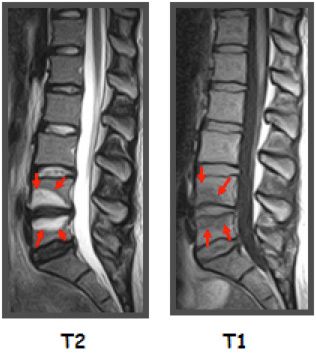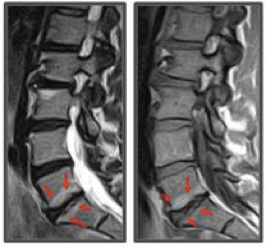by Alan Jordan
Modic changes were first described by Dr Michael Modic in 1988. These changes can only be seen on MRI scans and are divided into Modic Changes Types 1,2 and 3. The most common development is to have Modic Changes type 1 for a few years – these changes then become type 2 and occasionally type 3. In Modic Changes Type 1, many of the tiny bone-threads that form the scaffolding of the vertebra are fractured (microfractures). As opposed to healthy red bone marrow, the spaces between the bone-threads have been replaced with a clear liquid, similar to that found in a blister. This liquid can be more readily identified on a T2 weighted MRI scan as seen below. Modic Changes type 1 are highly correlated to lower back pain and have the appearance of bone oedema (swelling).
Modic Changes type 1.

On a T2 weighted scan (on the left) they appear as white swelling or inflammation while on a T1 weighted MRI scan they are less bright.
Modic Changes type 2 can be seen below. In Modic changes Type 2 there are also microfractures in the vertebrae however, the fluid has now become replaced with yellow fat. This results in a slightly different appearance on MRI scans, i.e. the Modic changes are light on both T1 and T2 weighted images though not as “bright” as Modic Changes type 1. Modic Changes type 2 are also strongly correlated to lower back pain, but slightly less that Modic Changes type 1.

Modic Changes type 3 appear dark on both T1 and T2 weighted MRI scans and are not associated with pain.
What Causes Modic Changes?
There are both a bacteriological cause (infection) as well as a mechanical cause. Bacterial were first identified by Dr Sterling in 1988 and essentially identical findings were replicated by Dr Hanne Albert and published last week in the European Spine Journal. Bacteria have been identified in slightly less than 50% of patients. These are likely the patients that have experienced the best clinical results in Dr Alberts’s randomised clinical trial, also recently published in the European Spine Journal.
More information on Modic Changes, antibiotic treatment, which patients are likely to have Modic changes and much more can be found on www.mastmedical.com
Dr Alan Jordan, Chiropractor Phd
Director; Broadgate Spine & Joint Clinic




